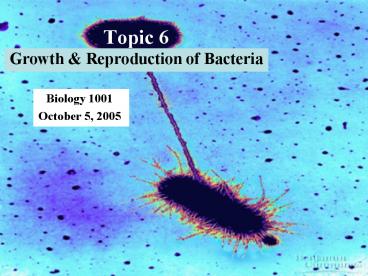Topic 6 Growth PowerPoint PPT Presentation
1 / 11
Title: Topic 6 Growth
1
Topic 6 Growth Reproduction of Bacteria
- Biology 1001
- October 5, 2005
2
Growth of Bacterial Populations
- Growth of bacteria refers to number rather than
size of cells - Under optimal conditions, a single prokaryote
cell divides to produce two daughter cells every
1-3 hours - Each round of division is a generation
- Bacterial population growth is therefore rapid
and exponential - 1 cell ? 2 cells ? 4 cells ? 8 cells ? 16 cells
etc. - A colony from a single cell in 12 hours
3
Bacteria Divide by Binary Fission
- Prokaryotes reproduce asexually by cell division
called binary fission - First, the bacterial chromosome begins to
replicate, starting at the origin of replication - Replication continues, one origin moves to the
opposite side of the cell, and the cell elongates - Replication finishes, the plasma membrane grows
inward, and a new cell wall is laid down - Produces two genetically identical daughter cells
clones - Binary fission is the evolutionary precursor to
mitosis
4
Mechanisms That Produce Variation
- If binary fission produces clonal offspring, why
are bacteria so genetically diverse??? - Two factors contribute to genetic diversity among
and within bacterial species - Mutation
- Recombination
5
Mutation
- A mutation is a change in the DNA of a gene,
ultimately leading to genetic diversity - Mutations can be spontaneous or caused by
mutagens - Spontaneous - Errors during DNA replication
- Mutagens - Chemical or physical factors that
damage DNA - Spontaneous mutations are extremely rare,
occurring on average only once in 10 million cell
divisions, per gene - Because bacteria divide rapidly exponentially,
mutation is a relevant factor generating genetic
diversity
6
Why Mutation Is Important For Bacterial
PopulationsExample
Thats 2 X 1010 / 10 million 2000 E. coli with
a mutation in a single gene per day. Multiplied
by the number of genes in the E. coli genome,
4300, thats 9 million mutated bacteria per day
in a single human host.
2 X 1010 new E. coli are produced per day in the
human intestine
Say the human population of 6 billion replaces
itself about once every 25 years. Because humans
have about 30,000 genes per genome thats about
18 million mutations in 25 years or only 2000
per day, in the entire human population.
7
Genetic Recombination
- The combining of DNA from two sources
- In sexually reproducing organisms this is the
main way genetic variation is produced - In eukaryotes, it involves the sexual processes
of meiosis and fertilization - In prokaryotes three other processes are used
transformation, transduction, and conjugation (
bacterial sex) - Results in horizontal gene transfer the
transfer of genetic material within a generation,
instead of from one generation to the next a
major force in the long-term evolution of bacteria
8
Conjugation
- The direct transfer of genetic material between
two bacteria cells that are temporarily joined - DNA transfer is one-way, from male to female
- The donor (male) uses an appendage called the
sex pilus that forms a cytoplasmic mating bridge - DNA gets transferred via this bridge in the form
of a plasmid - The plasmid encodes the ability to mate as well
as other traits such as antibiotic resistance
9
Transformation
- The alteration of a bacterial cells genotype and
phenotype by the uptake of naked, foreign DNA
from the surrounding environment - Many bacteria possess cell surface proteins that
facilitate transformation in natural populations - E. coli is used in biotechnology applications of
genetic recombination (genetic engineering) - Cells are cultured in high CaCl2 to become
competent - Cells are then transformed with human genes that
code for proteins such as insulin or growth
hormone that are needed in large amounts
10
Transduction
- Phages (viruses that infect bacteria) carry
bacterial genes from one host cell to another as
a result of mistakes in the phage reproductive
cycle - In the process called generalized transduction,
this transfer is random - Figure 18.16!?
11
Bacterial Populations Evolve Rapidly
- Natural selection operates on genetic (heritable)
variation, such as is generated readily by
mutation in bacteria - A mutation that confers a reproductive advantage
increases in frequency in subsequent generations,
and eventually becomes fixed in the population - Bacteria reproduce quickly and therefore have a
short generation time relative to most other
organisms - The rapid evolution of antibiotic resistance in
bacteria is a medically important example of
natural selection at work

